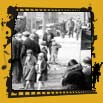 Heritage Community Foundation Presents
Heritage Community Foundation PresentsAlberta Online Encyclopedia
 |
 |
 |
|||
     |
Legacy Article "76 Trombones" 76 Trombones…were beyond their capacity, but Alberta's bandstands had a significance which belied their size. Both symbolically and functionally, they were a focal point for pioneer communities. The first foreigners to come to Alberta had little interest in making significant changes. As fur traders, the wilderness had value in its pristine state as a source of their merchandise. For about 100 years, minimal change occurred as a result of European presence. However, most of those who followed when the land passed to the jurisdiction of the Canadian government in 1871 had quite a different agenda. Rather than an ally, the untamed land was an adversary at worst, or at best a collection of raw materials to be exploited. In short order, towns and cities sprouted across the landscape. Many of the people who came had no experience of living in the wilderness, and no wish to gain such experience in anything more than a superficial way. In fact, it was their aim to make their new home as much like their old home as possible, as quickly as possible. Part of this process was the establishment of social and cultural institutions. In a land so dramatically replete with easily accessible green spaces, public parks would seem, at first blush, a superfluity. But they served a very important purpose— which had nothing to do with providing a healthful relief from urban living—and were to be found in a large proportion of Alberta's settlements. Parks, from the most rudimentary to the most elaborate, symbolized man's mastery of nature. Reorganized, tidied up, divested of any threat, and imbued with the amenities of civilization, what had formerly been an untamed, unsettling wilderness became a comfortable, even ennobling environment. The most modest examples might consist of an open area with symmetrically laid out paths lined with rocks. At the other end of the scale were romantic landscapes with paths winding through strategically thinned woods augmented by plantings of domesticated shrubs and flowers. Furnishings such as benches, bowers, and bridges in appropriately rustic style enhanced some parks. A few even boasted zoos, in which wildlife foolish enough to wander into town were penned. The crowning glory of any park was its bandstand. By no means did all parks possess this feature, but they were to be found across the whole range, from a simple open space in Blairmore, to a fully developed park complex in Edmonton. In this structure, the ideals of healthful outdoor living and the civilizing influence of music— which could calm the beasts—were united. The classic example consisted of a raised octagonal platform with a roof, supported by pillars at the perimeter, to provide shelter from the elements. More or less elaborate decorative woodwork might form a railing around the platform or a frieze under the eaves. This design allowed the musicians to be viewed, and their music to be heard, from all sides. The performers were simultaneously indoors and outdoors. Likewise, the audience was in nature but partaking of one of civilization's most sophisticated activities at one and the same time. Of course, nothing ever stays the same. Over the years bandstands served purposes distant from the intentions of the original builders. The above photographs provides graphic illustration of this fact. It shows a crowd gathering to protest oppressive anti-vagrancy laws instituted during the difficult Depression years. Most bandstands eventually deteriorated and were demolished, having lost the significance they held in earlier days. Today bandstands have reappeared but are generally viewed as quaint pieces of nostalgic garden furniture. True, they do create a feeling of yesteryear; but more importantly, they give concrete form to the ideals, hopes, and values of Alberta's pioneers. Dorothy Field, MSc., is Head of the Heritage Inventory program at Alberta Community Development, Historic Sites Services. |
|
|||
|
|
|||||
|
Copyright © 2003 Heritage Community Foundation All Rights Reserved |
|||||
 |
 |
 |
For more on Alberta's Arts Heritage, visit Peel’s Prairie Provinces.



